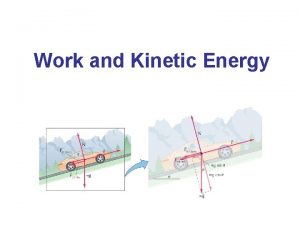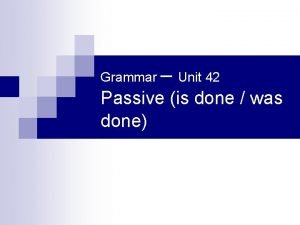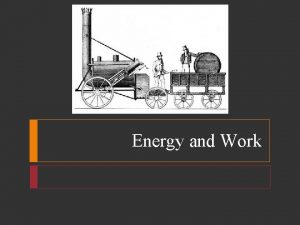Work and energy 1 Work Definition Work done










- Slides: 10

Work and energy 1. Work Definition: Work done by forces that oppose the direction of motion will be negative. Units: [W] = N*m = J Example: A block slides down a rough inclined surface. The forces acting on the block are depicted below. The work done by the frictional force is: A. Positive B. Negative C. Zero Wf = |fk| |Δx| cos(180°) = -|fk| |Δx| < 0 f Work done by the normal force: WN = |N| |Δx| cos(90°) = 0 Work done by weight: Wmg = mg|Δx| cos(θ ) > 0 1

2. Work kinetic energy principle Definition: W=K 2 - K 1 Example: An 80 -g arrow is fired from a bow whose string exerts an average force of 100 N on the arrow over a distance of 49 cm. What is the speed of the arrow as it leaves the bow? m = 80 g F = 100 N d = 49 cm v 1= 0 v 2 - ? 2

Example: Two blocks (m 1=2 m 2) are pushed by identical forces, each starting at rest at the same start line. Which object has the greater kinetic energy when it reaches the same finish line? 1. Box 1 2. Box 2 3. They both have the same kinetic energy Same force, same distance Same work Same change in kinetic energy Example: A ball is dropped and hits the ground 50 m below. If the initial speed is 0 and we ignore air resistance, what is the speed of the ball as it hits the ground? We can use kinematics or… the WKE theorem Work done by gravity: mgh 3

3. Potential energy a) Gravitational potential energy: b) Elastic potential energy (spring): 8. Conservation of energy in mechanics 4

Example: A box of unknown mass and initial speed v 0 = 10 m/s moves up a frictionless incline. How high does the box go before it begins sliding down? m Only gravity does work (the normal is perpendicular to the motion), so mechanical energy is conserved. We can apply the same thing to any “incline”! Turn-around point: where K=0 E K U v=0 h 5

Example: A roller coaster starts out at the top of a hill of height h. How fast is it going when it reaches the bottom? h Example: An object of unknown mass is projected with an initial speed, v 0 = 10 m/s at an unknown angle above the horizontal. If air resistance could be neglected, what would be the speed of the object at height, h = 3. 3 m above the starting point? 6

Example: Pendulum (Conservation of energy) Only weight of the pendulum is doing work; weight is a conservative force, so mechanical energy is conserved: m θ 0 L The angle on the other side is also θ 0! 7

4. Energy in the simple harmonic motion U E –A A x K t U t E t Total mechanical energy is constant through oscillation: conservation of energy! 8

5. Damped Harmonic Motion x(t) Damping force is proportional to velocity: t b – damping constant (Shows how fast oscillations decay) Optional math: 9

6. Resonance 10
 Work done and kinetic energy
Work done and kinetic energy Is done was done passive 1
Is done was done passive 1 Classification of size reduction equipment
Classification of size reduction equipment Aldanma cahilin kuru lafına
Aldanma cahilin kuru lafına Energy energy transfer and general energy analysis
Energy energy transfer and general energy analysis Energy energy transfer and general energy analysis
Energy energy transfer and general energy analysis Define workdone
Define workdone Definition of work done
Definition of work done Section 4 review physical science
Section 4 review physical science Work and energy section 2 describing energy answer key
Work and energy section 2 describing energy answer key Physics 03-01 work and the work-energy theorem
Physics 03-01 work and the work-energy theorem



















